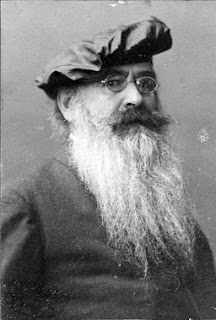A Portrait of Guido von List
*********
Guido von List (5 October 1848 - 17 May 1919) was born in Vienna, Austria. Throughout his youth, List was an avid outdoorsman. He spent considerable time boating and mountaineering. He also dedicated himself to the study of history, archeology, and anthropology. His thoughts on a wide range of subjects were recorded in numerous articles.[1]The youthful List was already demonstrating his interest in the mystical world. He later described an episode that occurred when he was only fourteen years old:
“After much asking, [I] received permission from my father to accompany him and his party who were planning to visit the catacombs [beneath St. Stephen’s Cathedral in Vienna] which were at that time still in their original condition. We climbed down and everything I saw and felt excited me with a kind of power that today I am no longer able to experience. Then we came—it was, if I remember correctly, in the third or fourth level—to a ruined altar. … At that point my excitement was raised to fever pitch, and before this altar I proclaimed out loud this ceremonial vow: ‘Whenever I get big, I will build a Temple of Wotan!’”[2]
In 1888, List published his first novel, Carnuntum, an historical tale centered around the old Roman city on the Danube that archeologists began to excavate in 1853.[3] In 1891 List, along with some friends, founded the group Iduna, the Independent German Society for Literature. List contributed an article on the mythic and historical ideas associated with the goddess Iduna to the society’s new journal, Iduna—Zeitschrift für Dichtung und Kritik (“Iduna—Journal for Literature and Critique”).[4]
With the turn of the twentieth century, List’s philosophy and ideas matured and turned to the more mystical and magical. Around this time he became familiar with the ideas and works of Helena Petrovna Blavatsky and the Theosophical movement.[5] While recuperating from cataract surgery in 1902-03, List experienced a mystical revelation in which it became apparent to him that there was a specific rune associated with each of the 18 verses or runic songs of the Hávamál ("The Words of the High One"). This revelation resulted in the publication, at age 60, of his Das Geheimnis der Runen (The Secret of the Runes). In Das Geheimnis der Runen, List documented explanations of the meanings of the runes. Beyond associating each of the 18 runes with a verse from the Hávamál, List sought to derive the root words for each from a primal Germanic language. He noted that most of these runic root-words were monosyllabic primal words. It is from these ancient Germanic primal or Ur-terms that he deduced meaning through what has been described as folk-etymology. List’s ideas on such primal terms were based on an adaptation of Indian doctrines on the mystical content of seed-words or syllables (bijas). List writes in what has become his magnum opus:
“…the song presents characterizations of the eighteen runes with mystical interpretations. When these strophes are paired with the names of the runes they enlighten us in a very special way and essentially provide the solution of the ‘secret of the runes.’”[6]
On 2 March 1908, the Guido-von-List Gesellschaft (Guido von List Society) was founded.[7] From this time, and until his death in 1919, List was quite prolific and turned out a series of volumes that would be remembered as his most important occult and esoteric works. These included: Die Armanenschaft der Ario-Germanen (The Armanism of the Aryo-Germanic People, 1908), Die Rita der Ario-Germanen (The Rita of the Aryo-Germanic People, 1908), Die Namen der Völkerstämme Germaniens und deren Deutung (The Names of the Tribes of the Peoples of Germany and their Interpretation, 1909), Die Religion der Ario-Germanen in ihrer Esoterik und Esoterik (The Religion of the Aryo-Germanic Folk: Exoteric and Esoteric, 1910), Der Übergang vom Wuotanismus zum Christentum (The Transition from Wuotanism to Christianity, 1911), Der Ursprache der Ario-Germanen und ihre Mysteriensprache (The Primordial Language of the Aryo-Germanic Peoples, 1915), and his final unpublished work, Armanismus und Kabbala (Armanism and Kabbalah).[8]
In June of 1911, Guido von List returned with eight friends to the Heathen Gate at Carnumtum and founded the High Armanen Order (HAO). In the years that followed, the HAO effectively shared List’s philosophy and ideas. Importantly, in 1915, List gave what has come to be known as his “Ostara Speech” in the inner circle of the HAO. In it, he warned against misuse of his ideas by political parties:
“In order to protect our teachings from being undermined and reduced to party slogans, we will not allows ourselves to meddle in party politics. Nor will we latch onto any party, since parties exist for as long as they are necessary; they will cease of their own accord when they have absolved of their duty. But we prepare the way for a new era, and this era shall not carry over anything from the old which is not connected to the innermost spirit of Armanentum.”[9]
In the years that followed, Guido von List would become a highly controversial figure. His insights and 18 Rune system however would remain the dominant Rune system for magical and occult practitioners into the 1990s. Today the Meister lives on with new editions of his works available in many languages throughout the world. Never before published English editions of his works have become widely available as well as biographical accounts. List’s system influenced generations of rune practitioners and magicians, some of whom are reluctant to mention his name or give him credit. Still, his ideas live on —foremost among them his explanation of the secrets of the runes.
Notes
1. See Stephen E. Flowers, “The Life of Guido von List” in Guido Von List, The Secret of the Runes, trans. Stephen E. Flowers (Rochester, VT: Destiny Books, 1988), 1-12.

.jpeg)
.jpg)
I've seen videos on Youtube purportedly made by the Holy Armanen Order, do you know anything about them ?
ReplyDelete